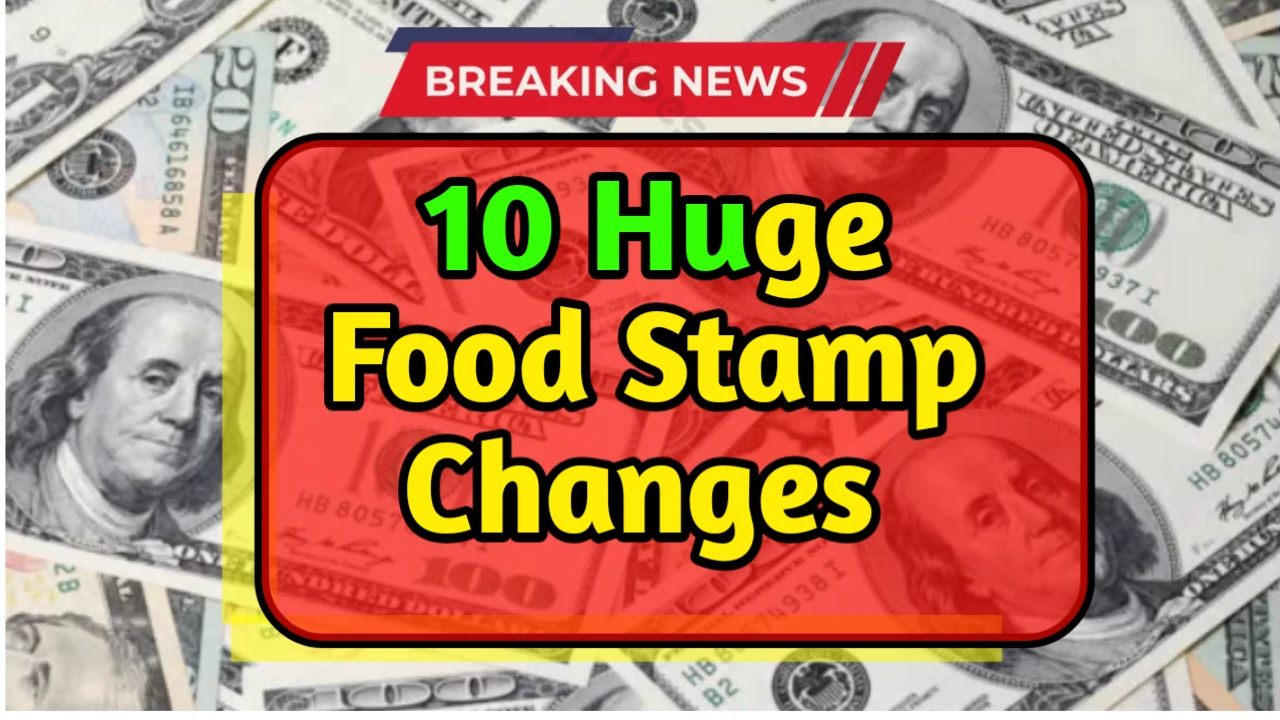10 Huge Food Stamp Changes: Increase In EBT + SNAP Audits, $120 SUN Bucks, Pilot Programs In 2025, the Supplemental Nutrition Assistance Program (SNAP), widely known as food stamps, is undergoing major transformations. With increased federal funding, new pilot programs, enhanced benefits, and stricter audits, millions of low-income families across the United States are expected to experience significant changes in how they access and use food assistance. These reforms aim to modernize the system, reduce fraud, and ensure better nutrition outcomes. If you rely on or are applying for SNAP benefits, it’s crucial to understand how these 10 key changes might affect you and your household.
1. Monthly EBT Amounts Increased in 2025
One of the most welcomed changes is the increase in monthly Electronic Benefit Transfer (EBT) amounts. The USDA has revised the Thrifty Food Plan again for 2025 to reflect current food prices, dietary needs, and inflation. This means more money for food purchases each month. A family of four could see an increase of up to $100 monthly depending on income level and location. The increase is automatic for those already enrolled, and beneficiaries can expect to see higher EBT balances beginning in summer 2025.
2. More Frequent and Stricter SNAP Audits
While benefits are rising, so is oversight. The USDA has announced an expansion of SNAP audit systems to combat fraud and misuse. Automated systems and manual reviews will be used more often to verify eligibility and detect irregularities. Participants may be asked to provide additional documents, including proof of income, rent, and household size. Households found violating SNAP rules could face disqualification or repayment penalties. While this change aims to protect program integrity, it also means that all beneficiaries should stay updated and maintain accurate records.
3. $120 SUN Bucks Summer Program for Children
A significant addition to food support this year is the new SUN Bucks initiative. This program provides $120 in summer EBT funds per eligible school-aged child. Designed to fill the gap left when schools are closed and school lunches are unavailable, SUN Bucks aims to combat summer hunger. Families of children who receive free or reduced-price school meals automatically qualify. The funds are loaded onto the child’s EBT card and can be used like regular SNAP benefits at participating grocery stores and farmers’ markets.
4. New Pilot Programs in Select States
In 2025, several states are launching SNAP pilot programs to test new benefit distribution models, digital platforms, and support services. These include home delivery options for rural households, integration with healthcare providers for nutrition counseling, and local produce incentive programs. States such as California, Texas, Michigan, and New York are among the early adopters. The goal of these pilot programs is to make SNAP more effective, flexible, and user-friendly for all demographics.
5. Digital Wallets and Mobile SNAP Apps
The USDA is working with tech partners to improve the SNAP user experience through mobile applications. Several states are piloting digital EBT wallets, which allow users to manage their benefits, check balances, and find local stores directly from their smartphones. This modernization helps reduce the burden of paper notices and improves access for younger and tech-savvy users. While this change is not yet nationwide, it is expected to expand further in 2026 if successful.
6. Changes in Eligibility Criteria
Eligibility requirements for SNAP have seen modifications in 2025. Income thresholds have been adjusted based on the federal poverty guidelines and inflation trends. Some asset limits and work requirements have also changed for adults without dependents. These criteria shifts are designed to reach more working-class families struggling with rising food costs. It’s recommended to check with your state’s SNAP office to determine whether you qualify under the new guidelines.
7. Nutrition-Focused Spending Incentives
The USDA is pushing a stronger focus on nutrition through SNAP. In 2025, many states are introducing programs that offer bonus dollars when beneficiaries purchase fruits, vegetables, and other healthy foods. For example, for every $10 spent on approved produce items, an additional $5 may be credited back to the EBT account. These incentives are part of a broader push to reduce long-term health care costs and promote wellness among low-income populations.
8. SNAP and School Meal Integration
Another big shift is the deeper integration between SNAP and school meal programs. Enrollment in SNAP will now automatically enroll children for free breakfast and lunch programs in participating school districts. This automatic enrollment aims to reduce paperwork for families and ensure that no child goes hungry during school hours. Schools are also receiving additional funding to provide higher-quality meals to students receiving food assistance.
9. Emergency Allotments Ending in Some States
Although the COVID-19 pandemic led to emergency SNAP allotments, many states have now begun phasing them out. In 2025, states that still had extended allotments will end them gradually. This will result in lower monthly benefits for some households. Families are encouraged to review their benefit letters carefully and seek community food resources if their allotment drops.
10. Enhanced Outreach and Language Accessibility
Finally, a notable administrative improvement in 2025 is the focus on outreach and language services. SNAP application processes are now more accessible in multiple languages and formats. New community outreach programs are in place to help elderly, immigrant, and rural populations understand their rights and navigate the application process. These efforts aim to reduce barriers and increase enrollment among underserved communities.
Table: Overview of the 10 SNAP Changes in 2025
| Change | Description |
|---|---|
| EBT Increase | Monthly food benefits increased due to inflation adjustments |
| SNAP Audits | More frequent eligibility checks and stricter oversight |
| $120 SUN Bucks | Summer EBT program for children to fight summer hunger |
| State Pilot Programs | New projects for digital access, home delivery, and wellness integration |
| Digital Wallets | Mobile app features for easier benefit tracking |
| Eligibility Reforms | Updated income thresholds and asset rules |
| Nutrition Incentives | Extra benefits for purchasing healthy food |
| SNAP & School Meals Integration | Automatic meal enrollment for SNAP children |
| End of Emergency Allotments | Reduction in benefits as COVID-19 extensions phase out |
| Outreach & Language Accessibility | Multilingual support and expanded community engagement |
| official website | https://www.fns.usda.gov/snap |
Final Thoughts Food Stamp Changes
The year 2025 marks a major transformation in how SNAP operates, delivers benefits, and interacts with recipients. From increased monthly allotments and child-focused programs like SUN Bucks to new technology and tighter audits, these changes reflect the government’s efforts to modernize and optimize food assistance for today’s economic climate. Beneficiaries must stay informed, monitor updates from their state SNAP agencies, and take proactive steps to ensure they receive the maximum support available.
These reforms, though vast, are meant to strengthen the safety net for low-income Americans and ensure no family is left behind in the fight against hunger. If you or someone you know relies on food stamps, now is the time to explore the new options, update your information, and take advantage of the support systems being rolled out across the country.
Disclaimer: This article is for informational purposes only and does not constitute legal, financial, or government advice. For official updates on SNAP benefits and eligibility, please refer to your state’s SNAP office or visit the official USDA website.






